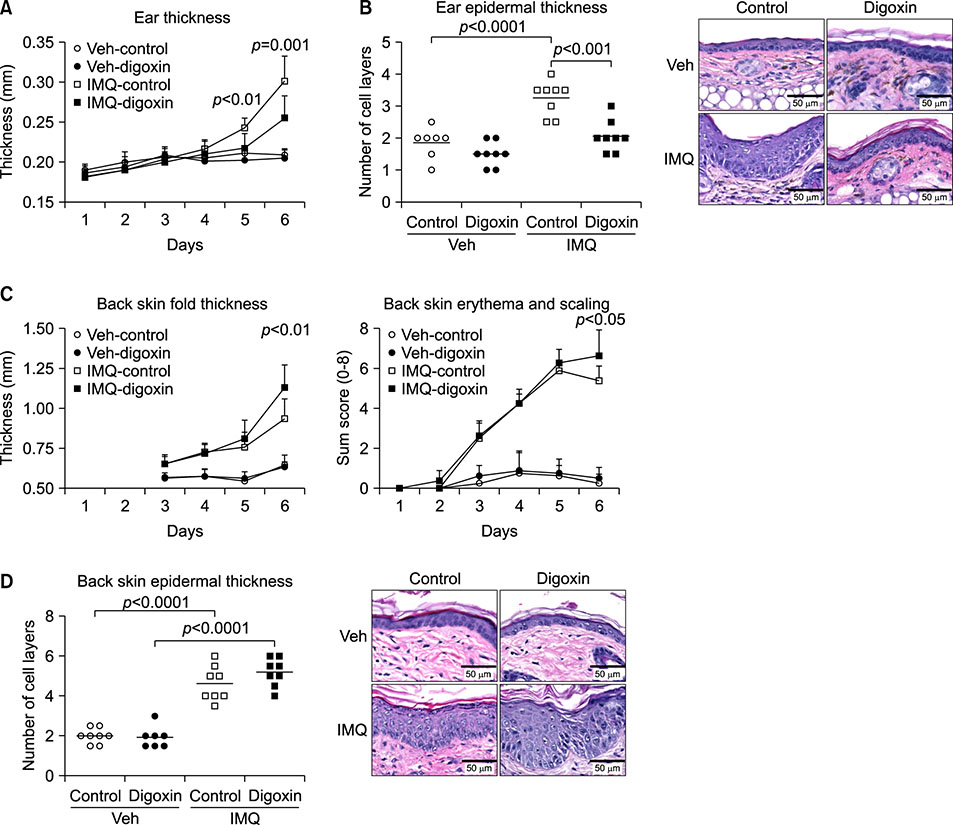Ann Dermatol.
2018 Aug;30(4):485-488. 10.5021/ad.2018.30.4.485.
Differential Effects of Digoxin on Imiquimod-Induced Psoriasis-Like Skin Inflammation on the Ear and Back
- Affiliations
-
- 1Department of Biomedical Sciences, University of Copenhagen, Copenhagen, Denmark. mariemad@sund.ku.dk
- 2Department of Clinical Biochemistry, Rigshospitalet, Copenhagen University Hospital, Copenhagen, Denmark.
- 3Department of Dermatology, Aarhus University Hospital, Aarhus, Denmark.
- 4Department of Cardiology, Herlev-Gentofte University Hospital, Hellerup, Denmark.
- KMID: 2457533
- DOI: http://doi.org/10.5021/ad.2018.30.4.485
Abstract
- No abstract available.
MeSH Terms
Figure
Reference
-
1. Martin DA, Towne JE, Kricorian G, Klekotka P, Gudjonsson JE, Krueger JG, et al. The emerging role of IL-17 in the pathogenesis of psoriasis: preclinical and clinical findings. J Invest Dermatol. 2013; 133:17–26.
Article2. van der Fits L, Mourits S, Voerman JS, Kant M, Boon L, Laman JD, et al. Imiquimod-induced psoriasis-like skin inflammation in mice is mediated via the IL-23/IL-17 axis. J Immunol. 2009; 182:5836–5845.
Article3. Ivanov II, McKenzie BS, Zhou L, Tadokoro CE, Lepelley A, Lafaille JJ, et al. The orphan nuclear receptor RORgammat directs the differentiation program of proinflammatory IL-17+ T helper cells. Cell. 2006; 126:1121–1133.
Article4. Banerjee D, Zhao L, Wu L, Palanichamy A, Ergun A, Peng L, et al. Small molecule mediated inhibition of RORγ-dependent gene expression and autoimmune disease pathology in vivo. Immunology. 2016; 147:399–413.
Article5. Pantelyushin S, Haak S, Ingold B, Kulig P, Heppner FL, Navarini AA, et al. Rorγt+ innate lymphocytes and γδ T cells initiate psoriasiform plaque formation in mice. J Clin Invest. 2012; 122:2252–2256.
Article6. Skepner J, Ramesh R, Trocha M, Schmidt D, Baloglu E, Lobera M, et al. Pharmacologic inhibition of RORγt regulates Th17 signature gene expression and suppresses cutaneous inflammation in vivo. J Immunol. 2014; 192:2564–2575.
Article7. Huh JR, Leung MW, Huang P, Ryan DA, Krout MR, Malapaka RR, et al. Digoxin and its derivatives suppress TH17 cell differentiation by antagonizing RORγt activity. Nature. 2011; 472:486–490.
Article8. Shi H, Mao X, Zhong Y, Liu Y, Zhao X, Yu K, et al. Digoxin reduces atherosclerosis in apolipoprotein E-deficient mice. Br J Pharmacol. 2016; 173:1517–1528.
Article9. Schaper K, Dickhaut J, Japtok L, Kietzmann M, Mischke R, Kleuser B, et al. Sphingosine-1-phosphate exhibits anti-proliferative and anti-inflammatory effects in mouse models of psoriasis. J Dermatol Sci. 2013; 71:29–36.
Article10. Grine L, Steeland S, Van Ryckeghem S, Ballegeer M, Lienenklaus S, Weiss S, et al. Topical imiquimod yields systemic effects due to unintended oral uptake. Sci Rep. 2016; 6:20134.
Article
- Full Text Links
- Actions
-
Cited
- CITED
-
- Close
- Share
- Similar articles
-
- Inhibition of Sphingosine-1-Phosphate Receptor 2 (S1P2 ) Attenuates Imiquimod-Induced Psoriasis-Like Skin Inflammation in BALB/c Mice
- The Amelioration Effect of the Ethanolic Extract of Cnidium officinale in Mice with Imiquimod-induced Psoriasis-like Skin Lesion
- Persicaria senticosa Ameliorates Imiquimod-induced Psoriasis-like Skin Lesions in Mice via Suppression of IL-6/STAT3 Expression and Proliferation of Keratinocytes
- Possible Role of Lysine Demethylase 2A in the Pathophysiology of Psoriasis
- Immunohistochemical Study of Psoriasis-related Gene Expression in Imiquimod-induced Psoriasis-like Mouse Model


